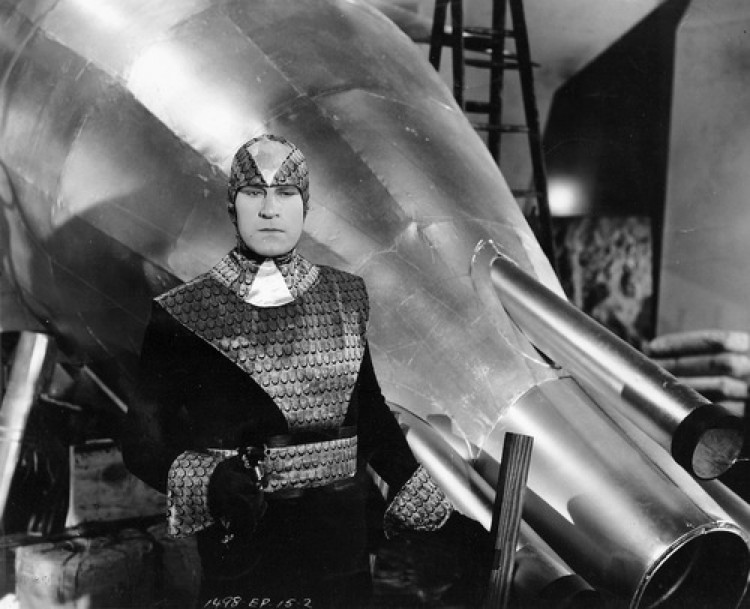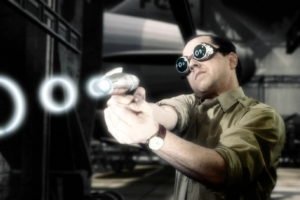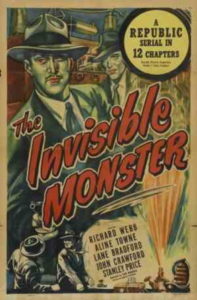
Now this is more like it! While not one of the classic cliffhangers from the early 1940s, The Invisible Monster, a 1950 Republic chapter-play, has what it takes to entertain me from start to end.
Starring as our hero Lane Carlson is played by Richard Webb, who became famous, four years later, as television’s Captain Midnight. Lane Carlson is an investigator who has been hired to hunt down The Phantom Ruler, a mad scientist who has discovered the secret of invisibility and plans to use it to rule the entire nation.
This serial opens a bit differently. Usually when the plot involves a power-mad looney intent upon mass destruction, the serial opens with a series of shots showing buildings blowing up, airships crashing, trains being derailed and that sort of thing. Then usually a newspaper headline or two, telling us that a mysterious power is threatening the city or country. Then we see the villain issuing his ultimatum.
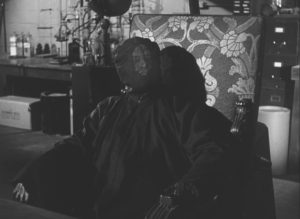
But not this one. This serial opens as a freight truck runs a blockade and delivers a group of four foreign scientists to the secret headquarters of The Phantom Ruler. One of the scientists, it should be noted, is played by John Hamilton, immediately recognizable as Daily Planet editor Perry White on the Adventures of Superman. Great Caesar’s Ghost!
At the mercy of The Phantom Ruler
These scientists, which The Phantom Ruler has smuggled into the country, are cold-war refugees who have fled from the oppression in their native lands. They will be forced to assist him in his scheme for evil domination. They will help him build an invisible army which will take over the city, first, and then the entire nation!
The Phantom Ruler is hooded and cloaked in robes of black that have been treated with a special chemical. When his outfit is subjected to certain special ultra-high frequency rays of light, he becomes invisible. In his hidden lair, he astounds the four scientists. They cannot see him! He turns off the beam and reveals himself, clad in his outfit of black.
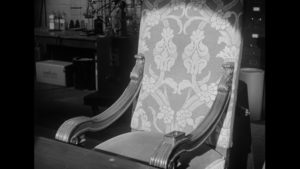
Of course, all these plans of national domination take money. And to acquire that money, The Phantom Ruler starts by entering the Tri-City Bank, under cover of invisibility, and robbing it of several hundred thousand dollars. The perfect crime!
The Apex Insurance Co., which has insured the Tri-City Bank (what, they’re not FDIC insured?), calls in crack private investigator Lane Carlson. Carlson, with his female assistant Carol Richards, sets out to find the gang responsible. And in doing so, he finds much more than just a gang. He finds the power-mad Phantom Ruler!
High-tech gadgets… for 1950
In many ways this is a standard serial in which the investigator tracks down a gang of criminals. But they throw in a few fancy high-tech sci-fi gadgets to add a touch of flair. Well, high-tech for 1950, I suppose. In The Phantom Ruler’s hidden lair, there’s always a wall filled with electronic equipment and two-way radios. All The Phantom Ruler’s henchmen have two-way radios in their cars, to report in to their leader regularly. They use initials: Calling P.R. Calling P.R. I suppose that’s so if anyone else happens across their wavelength, they won’t know this is The Phantom Ruler. But they seem to discuss their nefarious activities freely over the air, so maybe there’s another reason?
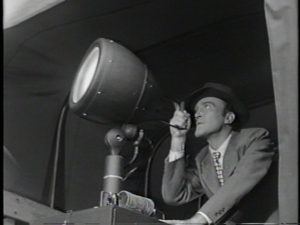
The Phantom Ruler is somewhat limited in where he can go while invisible. That’s because he needs the special light to be shining upon him. When the light interacts with the unique chemicals in his outfit, it renders him invisible.
So when The Phantom Ruler goes to invisibly rob a bank, snuff out a squealer or pick up a ransom, he dons his hood and robes. Then he has a henchman shine the special bright light on him. The light comes from a heavy floor lamp on wheels that’s carried around in the back of a large delivery truck.
The henchman moves the lamp to cast a bright beam for The Phantom Ruler to walk in. Of course the light doesn’t go through walls, so once The Phantom Ruler is inside the building, he’s no longer invisible. But it’s a great way to get from the truck to the backdoor of, say, a bank building unseen.
Now, don’t expect this to be logical…
It does seem to point out a flaw in The Phantom Ruler’s plan to use an invisible army to take over the nation. This army would have to walk around with their own individual floor lamps on wheels following after them, casting the bright rays to make them invisible. Exactly, how would that work? It’s an invasion, Colonel! I don’t see any soldiers, but a bunch of moving floor lamps is closing in upon us!
And what about those long extension cords that would be needed? I don’t think The Phantom Ruler really thought this through, very well. But then again, neither did the ten-year old adolescent males that made up the theater audiences watching these chapters. In their eyes, it all made sense. And it was glorious!
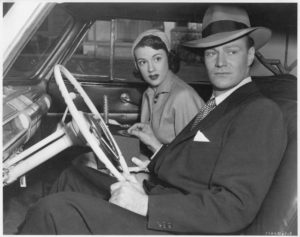
Everyone carries a revolver in this one. Even female assistant Carol Richards carries one, and uses it quite often, as well. But since no one seems to be a very good shot — lots of shots fired, but the target rarely hit — having a gun doesn’t seem to be much of an advantage.
Lane Carlson carries around a really cool fountain pen. It’s a trick pen with invisible ink in one end. It writes in normal ink, until he unscrews the center portion and reverses it. Then it writes in invisible ink. He uses it when forced to write a message at gun point, and inserts a secret invisible message below the forced one. Wow! How many boys in the theater went home and tried to make one of those cool pens?
He jumps juuuussst in time.
Many of the cliffhangers are the “he jumps in time” sort. Lane Carlson is blown up when an explosives-laden handcar in which he is a tied prisoner is rammed by an automobile. But not really. In the next chapter, we see that he frees himself and jumps out in just in time. In another chapter, a heavy steel door falls down, crushing our heroine. But next week, we discover she rolls out from under, in time. Then the car in which Lane and Carol are riding crashes into a truck containing flaming oil drums. They jump out in time. You begin to see the pattern.
Part of the cliffhangers are of the “it wasn’t as bad as it seemed” type. A hand grenade is thrown in front of our hero’s car. There’s a terrific explosion and the car disappears in a cloud of smoke and dust. When we see the resolution to the cliffhanger, it turns out that the explosion wasn’t as bad as we had feared. The car withstood the explosion and only got bogged down in the dirt road.
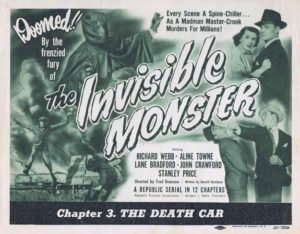
A car containing our unconscious hero crashes through an upper wall in a parking garage and plunges ten stories to the waters below. But in the next chapter, we find it wasn’t as bad as it seems. Our hero revives and swims away from the sinking car.
And then there’s the old “switcheroo” cliffhanger resolution. This one is used effectively at the beginning of chapter six, when we think Lane Carlson has been blown to smithereenees. The bad guys wait until his car is in the center of a bridge, then push the plunger on some dynamite they’ve mined the bridge with. But it turns out that a prisoner in the back seat of the car has taken control of the vehicle and dumped Carlson out along the side of the road. It’s the prisoner who gets blown up on the bridge. Ah, the old switcheroo. It’s a classic that never fails.
One of my favorite chapter endings is when Lane Carlson is electrocuted in a shower of sparks. It turns out that when the thug threw the crowbar at Carlson, it knocked Carlson to the floor but not into the electrified lamp. It was the crowbar that stuck the death trap and caused that eruption of sparking death. This general concept has been used in other serial cliffhangers as well, and never fails to satisfy.
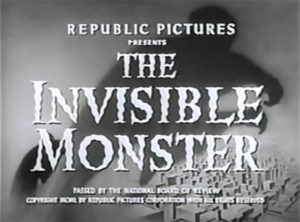
The hillsides are riddled with caves!
Have you ever noticed that these mad-scientist types always seem to set up their hideout in a mine or cave? In this serial, our master criminal starts out with his headquarters in a building. But by chapter six, he decides to move to… you guessed it… a cave. Or is it a mine? Looks like a cave, but has tracks and a mine car, so I guess it’s a mine. Whichever it is, it makes a great place in which our hero will face certain death. (Certain death — how many times have we heard that before?)
Lane Carlson has no clue that he is fighting against an invisible menace until chapter 10. That’s the economy chapter, made of mostly film clips of previous episodes. What a way to save money! Up until then, he just figures he’s fighting a gang of killers, robbers and whatever. But thanks to the flashbacks, he finally puts the pieces together and realizes that he is battling an unseen foe. Yeah, he’s a little slow on the uptake, but he finally gets a clue.
Carlson continues to face “certain” death for twelve straight weeks. During that time he weathers runaway cars, time bombs, acid baths and high voltage traps. But his battles against the invisible Phantom Ruler finally come to an end in chapter 12. The Phantom Ruler falls victim to his own death trap, the remaining scientists are freed, and the world is once again safe from The Invisible Monster.

By the way, the term “Invisible Monster” is never used by any character in the serial. It’s strictly used in the main title and on some of the chapter recap sub-titles. All the dialogue just refers to him as the “Phantom Ruler.”
It’s a good one!
Yep, I liked this serial. It’s a good one. Short. Fast-paced, pulpy fun. Cool gadgets. And, admittedly, a plot that doesn’t bear too close scrutiny. Yes, it has some loopholes in logic, but nothing that would dissuade a 10-year-old boy from plunking down his dime for 12 weeks in a row. And dream of having his own underground hideout where he, too, could become invisible.
